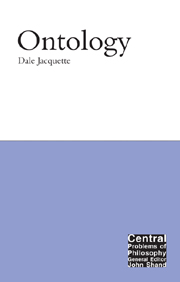Book contents
- Frontmatter
- Contents
- Preface
- Acknowledgements
- Introduction: Being as such
- I Pure philosophical ontology
- II Applied ontology and the metaphysics of science
- 6 Ontological commitment (on Quine)
- 7 Appearance, reality, substance, transcendence
- 8 Physical entities: space, time, matter and causation, physical states of affairs and events, natural laws
- 9 Abstract entities, particular and universal: numbers, sets, properties, qualities, relations, propositions and possibilities, logical, mathematical and metaphysical laws
- 10 Subjectivity of mind in the world of objective physical facts
- 11 God, a divine supernatural mind?
- 12 Ontology of culture: language, art and artefacts
- Conclusion: scientific–philosophical ontology
- Notes
- Bibliography
- Index
8 - Physical entities: space, time, matter and causation, physical states of affairs and events, natural laws
from II - Applied ontology and the metaphysics of science
- Frontmatter
- Contents
- Preface
- Acknowledgements
- Introduction: Being as such
- I Pure philosophical ontology
- II Applied ontology and the metaphysics of science
- 6 Ontological commitment (on Quine)
- 7 Appearance, reality, substance, transcendence
- 8 Physical entities: space, time, matter and causation, physical states of affairs and events, natural laws
- 9 Abstract entities, particular and universal: numbers, sets, properties, qualities, relations, propositions and possibilities, logical, mathematical and metaphysical laws
- 10 Subjectivity of mind in the world of objective physical facts
- 11 God, a divine supernatural mind?
- 12 Ontology of culture: language, art and artefacts
- Conclusion: scientific–philosophical ontology
- Notes
- Bibliography
- Index
Summary
A material-physical world
The category of physical entities is usually supposed to be the least metaphysically problematic in applied ontology. The question for a preferred existence domain is not whether physical entities exist. Their existence can be assumed as established by combinatorial pure philosophical ontology, on the assumption that there are non-actual logical possibilities, and hence distinct logically possible worlds, that all states of affairs logically must either be spatiotemporal or nonspatiotemporal, and that only physical or spatiotemporal entities can distinguish one logically possible world from another.
The existence of physical entities is further confirmed by empirical experience of the actual world in sense perception. To begin with, scientific knowledge of the actual world, impermissible in pure philosophical ontology, is unobjectionable and in many ways indispensable in applied scientific ontology. As we turn to pure logic to get started in pure philosophical ontology, so we turn to empirical science to get started in understanding the nature of physical entities in applied scientific ontology. As a result of our experience of the world we know that there are real existent external physical entities and states of affairs, and we can make progress towards the development of an appropriate applied scientific ontology of physical entities by looking to what are judged to be the most successful natural sciences as a starting place for articulating an applied ontology of physical entities from the standpoint of the things and kinds of things such theories need to posit in their respective preferred existence domains in order to sustain the truth of their principles, assumptions and conclusions.
- Type
- Chapter
- Information
- Ontology , pp. 193 - 205Publisher: Acumen PublishingPrint publication year: 2002



